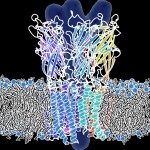Link to Pubmed [PMID] – 34117647
Link to HAL – Click here
Link to DOI – 10.1002/jcc.26701
J Comput Chem. 2021 Sep 5;42(23):1643-1661.
Coarse-grained normal mode analyses of protein dynamics rely on the idea that the geometry of a protein structure contains enough information for computing its fluctuations around its equilibrium conformation. This geometry is captured in the form of an elastic network (EN), namely a network of edges between its residues. The normal modes of a protein are then identified with the normal modes of its EN. Different approaches have been proposed to construct ENs, focusing on the choice of the edges that they are comprised of, and on their parameterizations by the force constants associated with those edges. Here we propose new tools to guide choices on these two facets of EN. We study first different geometric models for ENs. We compare cutoff-based ENs, whose edges have lengths that are smaller than a cutoff distance, with Delaunay-based ENs and find that the latter provide better representations of the geometry of protein structures. We then derive an analytical method for the parameterization of the EN such that its dynamics leads to atomic fluctuations that agree with experimental Bfactors. To limit overfitting, we attach a parameter referred to as flexibility constant to each atom instead of to each edge in the EN. The parameterization is expressed as a non-linear optimization problem whose parameters describe both rigid-body and internal motions. We show that this parameterization leads to improved ENs, whose dynamics mimic MD simulations better than ENs with uniform force constants, and reduces the number of normal modes needed to reproduce functional conformational changes.


